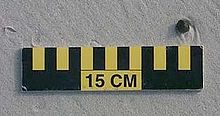Our website is made possible by displaying online advertisements to our visitors.
Please consider supporting us by disabling your ad blocker.
Tarball (oil)


A tarball is a blob of petroleum which has been weathered after floating in the ocean. Tarballs are an aquatic pollutant in most environments, although they can occur naturally and as such are not always associated with oil spills.[1][2][3]
- ^ Itah, A. Y.; Essien, J. P. (October 2005). "Growth Profile and Hydrocarbonoclastic Potential of Microorganisms Isolated from Tarballs in the Bight of Bonny, Nigeria". World Journal of Microbiology and Biotechnology. 21 (6–7): 1317–1322. doi:10.1007/s11274-004-6694-z.
- ^ Hostettler, Frances D.; Rosenbauer, Robert J.; Lorenson, Thomas D.; Dougherty, Jennifer (June 2004). "Geochemical characterization of tarballs on beaches along the California coast. Part I: Shallow seepage impacting the Santa Barbara Channel Islands, Santa Cruz, Santa Rosa, and San Miguel". Organic Geochemistry. 35 (6): 725–746. doi:10.1016/j.orggeochem.2004.01.022. ISSN 0146-6380.
- ^ Lorenson, T. D.; Hostettler, F. D.; Rosenbauer, R. J.; Peters, K. E.; Kvenvolden, K. A.; Dougherty, J. A.; Gutmacher, C. E.; Wong, F. L.; Normark, W. R. (2009). "Natural offshore seepage and related tarball accumulation on the California coastline; Santa Barbara Channel and the southern Santa Maria Basin; source identification and inventory". usgs.gov. US Geological Survey. Archived from the original on 2010-06-13. Retrieved 2010-06-03.
Previous Page Next Page


